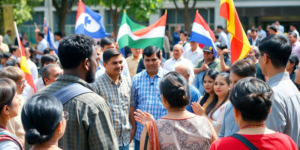Over 200 killed in Haiti’s Cite Soleil massacre, UN report finds 5
Highlighting violence crisis 2
The Wharf Jeremie Gang’s Reign of Terror
Origins and Rise of the Gang
The Wharf Jeremie Gang has become a notorious name in Haiti, especially in the troubled neighborhood of Cité Soleil. This gang didn’t emerge overnight; it has roots that dig deep into the socio-economic struggles of the area. Initially, they were just a small group trying to survive in the chaotic environment of Port-au-Prince, but over time, they evolved into a powerful force. The gang’s rise can be attributed to the lack of government presence, poverty, and the desperation that many locals face daily. As the state failed to provide basic services and security, groups like the Wharf Jeremie Gang filled the void, offering “protection” and other services, albeit through fear and violence.
Key Figures and Leadership
At the helm of the Wharf Jeremie Gang is Monel “Mikano” Felix, a figure both feared and revered in equal measure. Known as “King Micanor,” Felix’s leadership style is ruthless. He commands loyalty through intimidation and has been instrumental in orchestrating some of the gang’s most brutal acts. His ascent to power was marked by strategic alliances and an iron-fisted approach to dissent within his ranks. The gang’s leadership structure is tight-knit, with Felix at the center, ensuring that his orders are executed without question.
Impact on Local Communities
The impact of the Wharf Jeremie Gang on local communities is devastating. Residents live in constant fear, knowing that any perceived slight could result in violent retribution. The gang’s control extends beyond just physical dominance; they have a psychological grip on the community. Many families have been torn apart by their actions, with countless lives lost in the crossfire of their territorial disputes. The gang’s presence has led to a significant displacement of people, as families flee their homes in search of safety. The community’s social fabric is in tatters, with trust eroded not only between neighbors but also towards any form of authority. The violence and control exerted by the Wharf Jeremie Gang have left deep scars that will take years, if not decades, to heal.
The UN Report on the Cite Soleil Massacre

Findings and Statistics
The UN report sheds light on a grim chapter in Haiti’s recent history, revealing that 207 individuals were brutally killed in the Cite Soleil massacre. This tragic event unfolded over a few days in December, orchestrated by the notorious Wharf Jeremie gang. The report details how the gang executed victims using bullets and machetes, and then callously disposed of their bodies. Among the dead were many elderly individuals and Vodou practitioners, targeted under accusations of witchcraft.
Eyewitness Accounts
Eyewitnesses recount harrowing tales of violence and fear. The Wharf Jeremie gang, led by a figure known as “King Micanor,” allegedly sought revenge for the death of a gang leader’s son, whom he believed was cursed. Residents describe how gang members forcibly took people from their homes, never to return. The accounts paint a picture of a community terrorized and traumatized by this senseless violence.
International Reactions
The international community has reacted with shock and condemnation. The UN Security Council expressed deep concern over the escalating crisis in Haiti, emphasizing the need for justice and accountability. There’s a growing call for international intervention to address not only the immediate security challenges but also the underlying issues that allow such violence to flourish. Meanwhile, the Haitian government has promised to pursue those responsible, though skepticism remains about the effectiveness of these efforts.
The Aftermath of the Massacre in Haiti

In the wake of the horrific events in Cité Soleil, the Haitian government has been vocal about its commitment to justice. Authorities have acknowledged the brutal killings, particularly those targeting the elderly and practitioners of Vodou, and have vowed to prosecute the perpetrators. The justice system is under immense pressure to act swiftly and decisively, but the challenges are significant. The country’s legal infrastructure is fragile, and the pervasive influence of gangs makes it difficult to enforce the law effectively. International bodies, including the United Nations, have called for thorough investigations and accountability.
Following the massacre, humanitarian organizations rushed to provide aid to the affected communities. The need for food, shelter, and medical care is urgent, as many residents have been displaced. However, delivering assistance is fraught with difficulties. The security situation remains volatile, with gangs controlling large swathes of territory, complicating access for aid workers. Despite these hurdles, efforts continue to support those in dire need, with international agencies coordinating with local groups to maximize their impact.
The road to healing for the communities in Cité Soleil is long and arduous. Survivors and families of victims are grappling with immense trauma, and the psychological scars run deep. Community leaders and local organizations are at the forefront of initiatives aimed at fostering resilience and rebuilding trust. Cultural practices, including Vodou ceremonies, play a role in the healing process, providing comfort and a sense of continuity amid the chaos. As the community strives to overcome this tragedy, the spirit of unity and determination remains a beacon of hope.
The Broader Context of Violence in Haiti
Historical Background of Gang Violence
Haiti’s struggle with gang violence is not a new story. For decades, the country has been grappling with criminal networks that deeply impact its social and economic fabric. The roots of this issue trace back to political instability and poverty, which have created fertile ground for gangs to thrive. Over the years, these groups have become more organized and powerful, often filling the void left by a weak government. This has led to an environment where gangs can operate with relative impunity, spreading fear and chaos across communities.
Current Security Challenges
Today, the security situation in Haiti is dire. Gangs control large swathes of the capital, Port-au-Prince, and other regions, making daily life precarious for many residents. The recent surge in violence has pushed the death toll to alarming levels, with 5,000 lives lost in 2024 alone. The Haitian government, struggling to maintain order, faces immense challenges in curbing these violent outbreaks. Law enforcement is often outgunned and outnumbered, leading to a climate of insecurity that affects all aspects of life.
International Involvement and Support
International efforts to stabilize Haiti have been ongoing, but results have been mixed. Various peacekeeping missions have attempted to restore order, yet the complexity of the situation has often limited their success. Recently, a Kenyan-led police mission, backed by the US and UN, was deployed to assist local forces. However, the scale of the problem requires a more coordinated and sustained global effort. Many Haitians hope for a comprehensive strategy that not only addresses immediate security concerns but also tackles the underlying issues of poverty and governance that fuel the cycle of violence.
Reflecting on the Tragedy in Cité Soleil
The massacre in Cité Soleil is a grim reminder of the ongoing turmoil in Haiti. Over 200 lives were lost in a brutal display of violence, leaving families shattered and communities in mourning. This tragedy highlights the urgent need for stability and justice in the region. As the world watches, it’s crucial for international bodies and local authorities to work together to bring those responsible to justice and to prevent further bloodshed. The people of Haiti deserve peace and security, and it’s time for decisive action to ensure such atrocities do not happen again.













116 comments